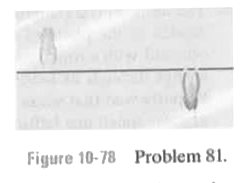How is a speed skater able to glide across the ice? How can the skater increase friction between the ice and the skates? What effect does an increase in friction have on the skater's speed ?
The skater is able to glide across the ice because there is little friction between the skate blades and the ice. The skater can increase the friction by forcing the blades of the skates against the ice. As a result of increase in friction the skater will slow or stop.
Similar Questions
What is done to increase friction between the tyres and road ?
View SolutionWhat is the effect of increase in temperature and pressure on the melting of ice?
View SolutionIn Fig. 10-78, two skaters, each of mass 50 kg, approach each other along parallel paths separated by 3.0 m. They have opposite velocities of 1.4 m/s each. One skater carries one end of a long pole of negligible mass, and the other skater grabs the other end as she passes. The skaters then rotate around the center of the pole. Assume that the friction between skates and ice is negligible. What are (a)the radius of the circle, (b) the angular speed of the skaters, and ( c) the kinetic energy of the two skater system? Next, the skaters pull along the pole unyil they are separated by 1.0 m. What then are (d) their angular speed and (e) the kinetic energy of the system? (f) What provided the energy for the increased kinetic energy?

View SolutionWhen .you tighten a nut on a bolt, how are you increasing the frictional force ?
View SolutionIf tension of a sire is increased to four times, how is the wave speed changed?
View SolutionWhat is an electomagnet ? How the stregenth of the electromagnet can be increased ?
View SolutionA circular race track is banked at 45∘ and has a radius of 40 m. at what speed does a car have no tendency to slip? If the coefficient of friction between the wheels and the track is 12, find the maximum speed at which the car can travel round the track without skidding.
View SolutionTwo skaters each of mass 50kg, approach each other along parallel paths separated by 3m. They have equal ad opposite velocities of 10m/s. The first skater carries a long light pole, 3m long, and the second skater grabs the end of it as he passes (assume frictionless ice).
a. Described quantitatively the motion of the skaters after they are connected by the pole.
b. By pulling on the skaters reduce their distance to 1m. What is their motion then?
c. Compare the KEs of the system in parts a. and b. where does the change come from?
View SolutionBy how much does the speed of sound increase with rise of temperature ?
View SolutionIs there a force of friction between the wheels of a moving train and iron rails? If yes, name the type of friction. If an air cushion can be introduced between the wheel and the rail, what effect will it have on the friction?
View Solution
